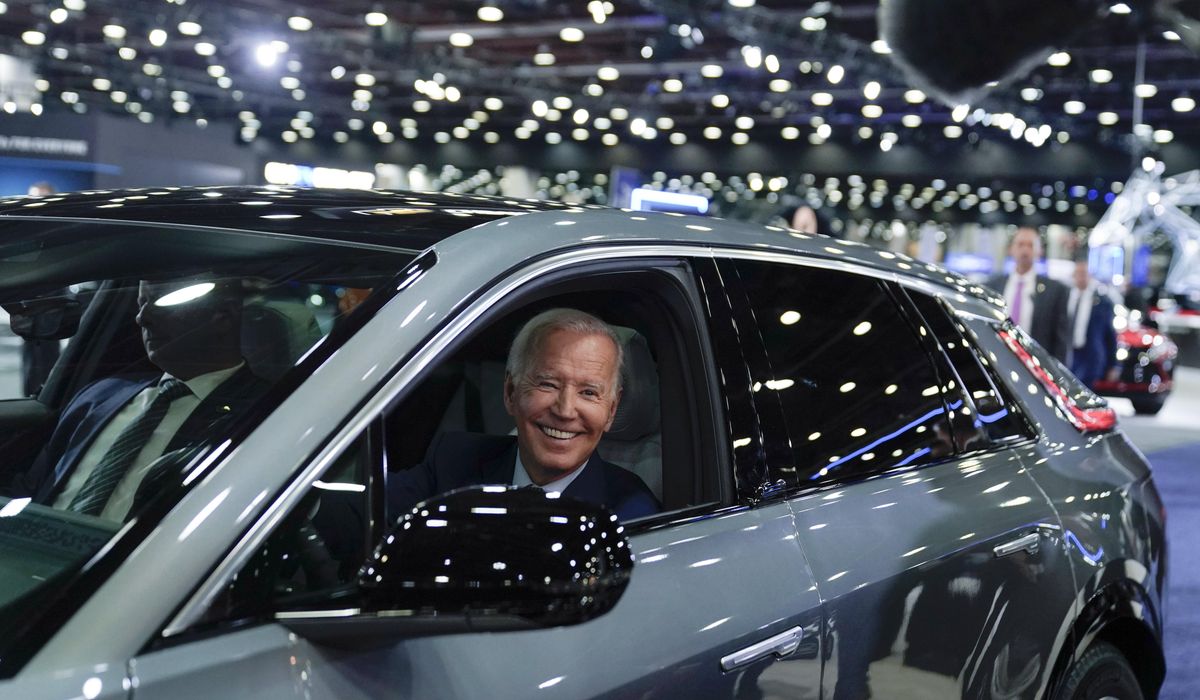


The Biden administration on Wednesday finalized stringent new tailpipe emission rules that will force automakers to toss most of their gas-powered models to the curb by 2030 and sell primarily electric vehicles.
The unprecedented move from the Environmental Protection Agency is part of President Biden’s climate change agenda meant to overhaul the U.S. auto industry and Americans’ travel habits, but it’s expected to face legal challenges.
“With transportation as the largest source of U.S. climate emissions, these strongest-ever pollution standards for cars solidify America’s leadership in building a clean transportation future and creating good-paying American jobs, all while advancing President Biden’s historic climate agenda,” said EPA Administrator Michael Regan.
The new fleetwide standards will start with vehicle model year 2027 and phase in gradually until fully implemented with model year 2032, by which time new vehicle sales will need to be roughly two-thirds electric. By severely regulating the amount of emissions an automaker’s fleet can produce, a majority of EVs will need to be sold to comply.
The administration forged ahead with its plan despite pleas from thousands of car dealerships across the country, warnings from industry leaders and major manufacturers slashing production. Demand in recent years has failed to meet growth expectations.
Critics accused President Biden of playing politics to bolster his reelection this fall and boost support among his base.
“This is purely being done for campaign reasons — to appease the climate alarmists and leftist donors that are driving this movement towards really what is an attempt to cancel our energy, which increases the cost of everything,” said Jason Isaac, founder and CEO of American Energy Institute.
Senate Minority Leader Mitch McConnell, Kentucky Republican, said Mr. Biden “keeps trying to sell working families on electric vehicles, but the American people aren’t buying the hype.”
The American Fuel & Petrochemical Manufacturers and the American Petroleum Institute — major energy lobbying groups — threatened legal action.
The associations said that short of Congress “overturning this deeply-flawed regulation,” their “organizations are certainly prepared to challenge it in court.”
Congressional Republicans, led by Sens. Pete Ricketts of Nebraska and Dan Sullivan of Alaska, said they will file legislation to repeal the mandate under what’s known as the Congressional Review Act, which will force a vote despite Democratic control of the Senate.
“This rule is delusional,” the senators said. “This is the Biden administration‘s attempt to get rid of the internal combustion engine without congressional authority.”
Although sales of all-electric and plug-in hybrid vehicles continue to grow year over year, it would take the U.S. decades at its current pace to meet the administration‘s 2032 goal.
Roughly 9% of vehicles sold in 2023 were plug-in hybrids or all-electric, compared to less than 7% in 2022. All-electric models last year accounted for just 7%.
By 2032, the EPA wants all new light-duty vehicles to be 67% electric and up to 32% for medium-duty vehicles. That includes a mixture of all-electric, plug-in electric hybrids and battery electric hybrids.
Against the prodding of climate activists for even stricter rules, the EPA‘s final decision marked a slight reversal from its original proposal in the face of pressure from manufacturers and the United Auto Workers union for more transition time.
Senior administration officials, who spoke with reporters by phone but declined to be named, said they will allow hybrids to help manufacturers meet the standards rather than relying solely on all-electric vehicles to achieve the 67% electric threshold. They predict that by 2032, all-electric will account for roughly 56% and plug-in hybrids will be 13%.
Automakers can meet the fleetwide emission standards with a variety of EV technologies, including plug-in electric hybrids, battery electric hybrids and cleaner gas-powered cars.
In addition, the EPA is allowing manufacturers the option to only begin meeting the emission standards in 2030 or 2031 rather than starting gradually in 2027, depending on the vehicle size and weight. This is to “provide manufacturers with additional time to adjust product plans and apply technologies to vehicles,” officials said.
The Alliance for Automotive Innovation, which represents major automakers, hailed the changes and the final regulation but still described the administration‘s targets as “a stretch goal.”
Light-duty vehicles and trucks less than 6,000 pounds must still start complying in 2027 but light-duty trucks between 6,001 and 8,500 pounds and medium-duty passenger vehicles between 8,501 to 14,000 pounds can wait until 2030. Medium-duty vehicles like larger pickup trucks weighing between 8,501 and 14,000 pounds can wait until 2031.
The EPA admitted it expects higher sticker prices because the environmental regulations will cost the auto industry an estimated $40 billion per year. The senior administration officials insisted those costs would be offset over the life of more efficient vehicles due to lower maintenance and fuel costs.
The EPA estimates the standards will cost manufacturers an average of about $1,200 per light-duty vehicle and $1,400 for medium-duty vehicles.
One of the factors that have stopped more consumers from going green is EVs’ higher prices compared to their gas-powered equivalents.
Senior administration officials held an event Wednesday in Washington to celebrate the regulations. Those in attendance included Mr. Regan, White House National Climate Adviser Ali Zaidi, former Vice President Al Gore and President and Alliance for Automotive Innovation CEO John Bozzella.
q
• Ramsey Touchberry can be reached at rtouchberry@washingtontimes.com.
